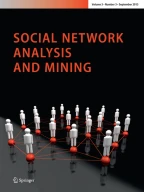Abstract
In this work, we develop a flexible methodology for detecting specific notions of community, with a focus on overlapping communities in social networks. Because the word “community” is an ambiguous term, it is necessary to quantify what it means to be a community within the context of a particular type of problem. Our interpretation is that this quantification should be done at a minimum of three scales. These scales are at the level of: individual nodes, individual communities, and the network as a whole. Each of these scales involves quantitative features of community structure that are not accurately represented at the other scales, but are important for defining a particular notion of community. We exemplify sensible ways to quantify what is desired at each of these scales for a notion of community applicable to social networks, and use these models to develop a prototypical community detection algorithm. Some appealing features of the resulting method are that it naturally allows for nodes to belong to multiple communities, and is computationally efficient for large networks with low overall edge density. The scaling of the algorithm is \(O(N\overline{k^2} + \overline{N_{\rm com}^2})\), where N is the number of nodes in the network, \(\overline{N_{\rm com}^2}\) is the average squared community size, and \(\overline{k^2}\) is the expected value of a node’s degree squared.
Similar content being viewed by others
Notes
http://www.cpc.unc.edu/projects/addhealth/.
References
Amelio A, Pizzuti C (2014) Overlapping community discovery methods: a survey. In: Social networks: analysis and case studies. Springer, Vienna, pp 105–125
Auffarth B (2007) Spectral graph clustering. Universitat de Barcelona, course report for Technicas Avanzadas de Aprendizaj, at Universitat Politecnica de Catalunya
Brand M, Huang K (2003) A unifying theorem for spectral embedding and clustering. In: Proceedings of the ninth international workshop on artificial intelligence and statistics
Danon L, Diaz-Guilera A, Duch J, Arenas A (2005) Comparing community structure identification. J Stat Mech 2005(09):P09008
Evans TS, Lambiotte R (2009) Line graphs, link partitions, and overlapping communities. Phys Rev E 80(1):016105
Fortunato S (2010) Community detection in graphs. Phys Rep 486(3):75–174
Girvan M, Newman MEJ (2001) Community structure in social and biological networks. arXiv preprint cond-mat/0112110
Hric D, Darst RK, Fortunato S (2014) Community detection in networks: structural communities versus ground truth. Phys Rev E 90(6):062805
Lancichinetti A, Fortunato S (2009) Benchmarks for testing community detection algorithms on directed and weighted graphs with overlapping communities. Phys Rev E 80(1):016118
Lancichinetti A, Fortunato S (2009) Community detection algorithms: a comparative analysis. Phys Rev E 80(5):056117
Lancichinetti A, Fortunato S, Kertész J (2009) Detecting the overlapping and hierarchical community structure in complex networks. New J Phys 11(3):033015
Palla G, Derényi I, Farkas I, Vicsek T (2005) Uncovering the overlapping community structure of complex networks in nature and society. Nature 435(7043):814–818
Pool S, Bonchi F, van Leeuwen M (2014) Description-driven community detection. ACM Trans Intell Syst Technol 5(3):28
Raghavan UN, Albert R, Kumara S (2007) Near linear time algorithm to detect community structures in large-scale networks. Phys Rev E 76(3):036106
Rees BS, Gallagher KB (2010). Overlapping community detection by collective friendship group inference. In: IEEE international conference on advances in social networks analysis and mining (ASONAM), pp 375–379
Rees BS, Gallagher KB (2012) Overlapping community detection using a community optimized graph swarm. Soc Netw Anal Min 2(4):405–417
Shen H-W, Cheng X-Q (2010) Spectral methods for the detection of network community structure: a comparative analysis. J Stat Mech 2010(10):P10020
Wilson JD, Wang S, Mucha PJ, Bhamidi S, Nobel AB (2014) Nobel A testing based extraction algorithm for identifying significant communities in networks. Ann Appl Stat 8(3):1853–1891
Xie J, Kelley S, Szymanski BK (2013) Overlapping community detection in networks: the state-of-the-art and comparative study. ACM Comput Surv 45(4):43
Zachary W (1977) An information flow modelfor conflict and fission in small groups1. J Anthropol Res 33(4):452–473
Acknowledgments
The authors are grateful to the anonymous reviewers (especially one of them) for their insightful comments and suggestions that greatly improved the content and presentation of this manuscript.
Author information
Authors and Affiliations
Corresponding author
Rights and permissions
About this article
Cite this article
Brutz, M., Meyer, F.G. A flexible multiscale approach to overlapping community detection. Soc. Netw. Anal. Min. 5, 23 (2015). https://doi.org/10.1007/s13278-015-0259-z
Received:
Revised:
Accepted:
Published:
DOI: https://doi.org/10.1007/s13278-015-0259-z
